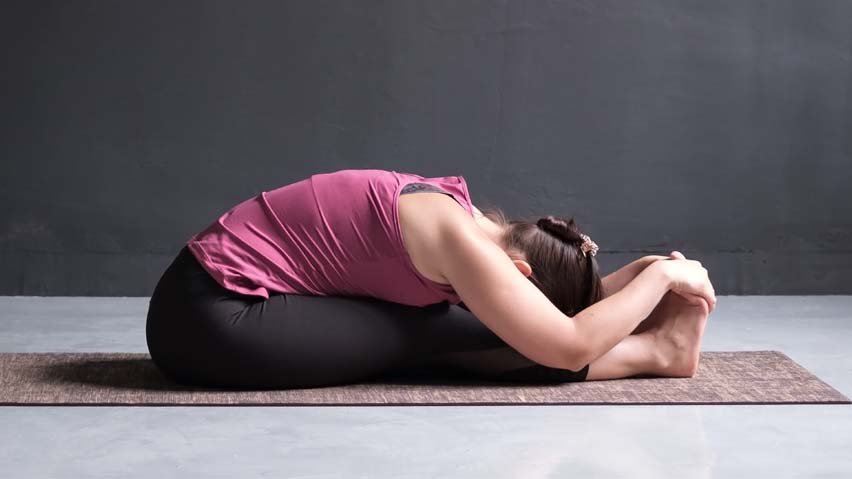Paschimottanasana Yoga: Unlocking Serenity and Flexibility with Seated Forward Bend
Table of Contents
Introduction
Paschimottanasana Yoga, commonly known as Seated Forward Bend, is a rejuvenating and calming yoga posture that stretches the entire back body, improves flexibility, and cultivates a sense of inner peace. Derived from the Sanskrit words “paschima” (meaning west or back), “uttana” (meaning intense stretch), and “asana” (meaning pose), Paschimottanasana Yoga invites us to fold forward with grace, fostering a deep connection between the body, mind, and breath.
In this article, we will explore the steps, benefits, variations, and precautions associated with Paschimottanasana Yoga, empowering you to incorporate this transformative pose into your yoga practice.
How to Perform Paschimottanasana Yoga
To practice Paschimottanasana Yoga, follow these step-by-step instructions:
Step 1: Begin by sitting on your mat with your legs extended in front of you, feet flexed and toes pointing upward.
Step 2: Engage your core muscles and lengthen your spine, ensuring a tall and upright posture.
Step 3: On an inhale, extend your arms overhead, reaching toward the ceiling.
Step 4: On an exhale, slowly hinge forward from your hips, leading with your chest and keeping your spine as straight as possible.
Step 5: Reach your hands toward your feet, ankles, or shins, whichever is accessible to you without straining.
Step 6: Maintain a gentle and relaxed gaze forward, and avoid rounding your back excessively.
Step 7: Breathe deeply and hold the pose for 30 seconds to a minute, gradually increasing the duration as your flexibility improves.
Step 8: To release the pose, engage your core, slowly lift your torso, and return to an upright seated position.
Benefits of Paschimottanasana Yoga
Regular practice of Paschimottanasana offers a wide range of physical and mental benefits, including:
a. Deep Stretching: Seated Forward Bend provides a deep stretch to the hamstrings, calves, lower back, and spine, promoting increased flexibility and releasing tension in these areas.
b. Improved Digestion: The gentle compression of the abdominal region in Paschimottanasana stimulates the digestive organs, aiding digestion and relieving constipation.
c. Calmness and Stress Relief: The forward folding motion in this pose helps to calm the mind, soothe the nervous system, and promote a sense of tranquility and relaxation.
d. Enhanced Spinal Health: Paschimottanasana elongates and strengthens the entire length of the spine, improving posture and relieving back pain.
e. Improved Blood Circulation: The forward bend in this pose stimulates blood flow to the abdominal organs, kidneys, and liver, promoting detoxification and rejuvenation.
f. Mental Focus and Clarity: The combination of the pose’s forward folding action and deep breathing encourages a state of introspection and concentration, enhancing mental focus and clarity.

Variations of Paschimottanasana Yoga
Explore these variations of Paschimottanasana Yoga to deepen your practice and target specific areas:
a. One-Legged Forward Bend: Extend one leg forward while bending the other knee and bringing the sole of the foot against the inner thigh of the extended leg. Fold forward over the extended leg, deepening the stretch in the hamstring and calf.
b. Wide-Legged Forward Bend: Open your legs wider than hip-width apart and fold forward, aiming to bring your chest and head closer to the ground. This variation targets the inner thighs and groins while providing a deeper stretch to the hamstrings and lower back.
c. Seated Forward Bend with Twist: From the seated position, twist your torso to one side and place the opposite elbow on the outside of the bent knee. This variation adds a spinal twist, providing additional benefits to the spine and improving spinal mobility.
Precautions and Contraindications
While Paschimottanasana is generally safe for most practitioners, it’s important to consider the following precautions:
a. Avoid this pose if you have a recent or chronic back injury or any condition that restricts forward folding or bending of the spine. Seek guidance from a healthcare professional or an experienced yoga instructor.
b. If you have a hamstring injury, practice Paschimottanasana Yoga with caution, keeping a gentle bend in the knees and avoiding excessive strain on the hamstrings.
c. Pregnant women should practice Paschimottanasana with modifications, such as keeping the legs slightly separated and avoiding deep forward folds.
Conclusion
Paschimottanasana, the Seated Forward Bend, invites you to embrace serenity, flexibility, and inner connection. Through regular practice of this pose, you can experience increased flexibility in the back body, improved digestion, and a sense of calm and tranquility. Approach Paschimottanasana with mindfulness, honoring your body’s limits and respecting its unique needs.
As you fold forward, allow the benefits of this pose to unfold, nurturing your body, mind, and spirit. Embrace the transformative power of Paschimottanasana and weave it into your yoga practice, as you journey toward greater flexibility, peace, and self-discovery.





